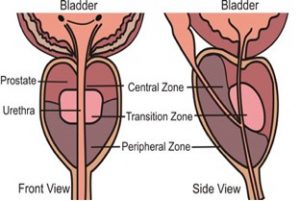Why do we have a prostate?
Simple – its one and only function is human reproduction. The semen that is ejaculated during sex is made up of a mixture of three types of fluids:
- Sperm, which makes up less than 1%. These are made in each testicle, and from there migrate up until ejaculated.
- Fluid from the prostate – about 30%. Without this a man would be infertile.
- Fluid from the two seminal vesicles makes up the remaining near 70%.

What does it do?
The prostate is essential for reproduction for a number of reasons.
- The fluid produced is alkaline, which protects fragile sperm in the acid environment of the female vagina.
- It is responsible for liquefying sperm immediately after ejaculation, with the aid of a number of enzymes. The most notable of which is one known as Prostate Specific Antigen (PSA).
- On ejaculation, the muscles in the prostate propel the semen into the penis and from there out into the world.
- At the same time, other muscles in the prostate and bladder tighten a valve just below the bladder, to stop any urine mixing with the semen and simultaneously preventing semen from going backwards up into the bladder.

Anatomy of the Prostate
Think of the prostate as being roughly like an onion with three layers – inner, middle and outer – surrounding a tube like a soft drinking straw. This tube is called the urethra. The urethra comes down from the bladder and ends at the tip of the penis. It transmits both urine and semen, but thankfully not both together.
The three layers of the prostate are:
- The innermost layer, called the ‘Transitional zone’. This is the thinnest layer, about 5% of the gland. It is mainly made up of thousands of small lubricating glands. Although it is the smallest, it causes lots of problems. As men get older, it increases in size far more than the other layers, and gradually presses on and blocks the urethral tube running through the middle of it.
- The middle layer is called the ‘Central zone’. It makes up about 35% of the prostate. It produces some prostatic fluid, and tends not to cause problems.
- The outer layer is the ‘Peripheral zone’. It is not the same thickness all round, being thinnest at the front of the prostate, and thicker at the back. It is important because most prostate cancers arise in this layer, and are at the back of the gland.


